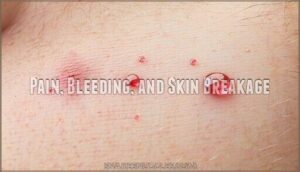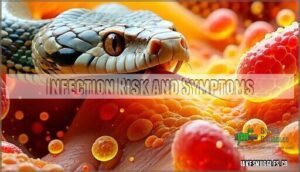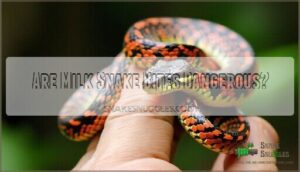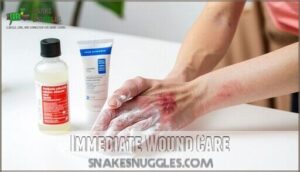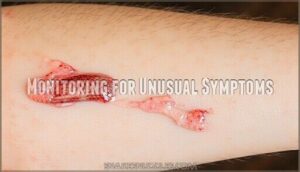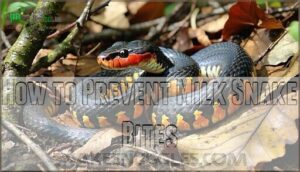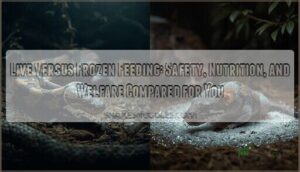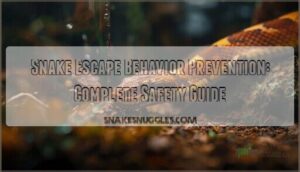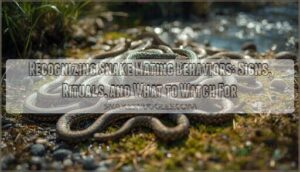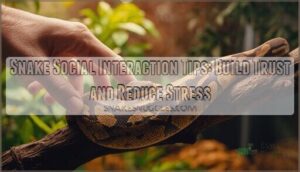This site is supported by our readers. We may earn a commission, at no cost to you, if you purchase through links.
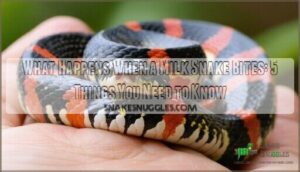
Since milk snakes can’t inject venom, you’re looking at minor skin breaks—not a medical crisis.
Wash the small wounds with soap and water, dab on some antiseptic to keep bacteria out. Keep an eye out for weird swelling or redness, but problems are pretty uncommon.
The biggest challenge isn’t the bite itself—it’s telling milk snakes apart from their dangerous look-alikes.
Table Of Contents
- Key Takeaways
- What Happens When a Milk Snake Bites?
- Are Milk Snake Bites Dangerous?
- Why Do Milk Snakes Bite?
- First Aid Steps for a Milk Snake Bite
- How to Prevent Milk Snake Bites
- Frequently Asked Questions (FAQs)
- What species of milk snake is most common in my area?
- How can I identify a milk snake?
- Why do milk snakes vibrate their tails?
- Do milk snakes carry diseases that can infect humans?
- Can milk snakes be safely kept as pets?
- Do milk snake bites require tetanus shots?
- How long do milk snake bite marks last?
- Can milk snakes transmit diseases through biting?
- What time of year are milk snakes most likely to bite?
- Do baby milk snakes bite differently than adults?
- Conclusion
Key Takeaways
- You’ll feel a quick pinch like a cat’s gentle nip, followed by tiny puncture wounds that barely bleed—the sensation lasts only seconds before fading completely.
- You don’t need to worry about venom since milk snakes can’t inject any toxins, making their bites a minor skin issue rather than a medical emergency.
- Clean the small wounds with soap and water, then apply antiseptic to prevent bacterial infection—complications are rare but watch for unusual swelling or redness.
- You’re more likely to get bitten when you accidentally startle them or handle them improperly, since they only bite as a last resort when they feel cornered or can’t escape.
What Happens When a Milk Snake Bites?
When a milk snake bites, you’ll usually feel a quick pinch or pressure sensation rather than sharp pain, since these non-venomous snakes have small teeth designed for gripping prey.
Most bites don’t break the skin, but if they do, you’ll see minor bleeding and small puncture marks that heal quickly with basic first aid.
Typical Bite Sensations (Pinch, Pressure)
Most milk snake bites feel like a gentle pinch or light pressure rather than sharp pain. These nonvenomous constrictors have relatively weak bite force compared to other snakes, making encounters surprisingly mild for most people.
What you’ll commonly experience:
- Light pinching sensation similar to a cat’s gentle nip
- Brief pressure from their small teeth making contact
- Minimal discomfort that fades within seconds
- Sensory receptors detect touch more than actual pain
- Psychological impact often exceeds physical sensation
Bite location and individual sensitivity affect your experience, but nonvenomous snakes like milk snakes rarely cause significant discomfort. Their biting habits focus on defense rather than damage.
Pain, Bleeding, and Skin Breakage
Bite severity varies with each encounter—some milk snake bites barely break skin, while others create small puncture wounds. You’ll usually see minimal bleeding that stops within minutes.
The skin reaction resembles tiny needle pricks rather than deep lacerations. These bite wounds heal quickly without scarring potential when you clean them properly immediately after contact.
Infection Risk and Symptoms
While bite wounds from milk snakes rarely break skin, bacterial infections can still occur. Wound cleaning prevents secondary infections from salmonella bacteria and other common illnesses. Snakes can act as a reservoir of zoonotic diseases.
Watch for increased pain, swelling, or redness—signs your body’s fighting bacterial infections. Allergic reactions are uncommon but possible. Proper symptom monitoring helps catch problems early, keeping minor snake bites manageable.
When to Seek Medical Attention
Milk snake bites usually don’t need medical attention since they’re non-venomous. But if you’re not sure what bit you, better to get it checked out.
Watch for these signs that warrant veterinary care or a doctor’s visit:
- Unusual symptoms like severe swelling, persistent bleeding, or spreading redness
- Bite complications in people with pre-existing conditions or compromised immune systems
- Signs of infection from salmonella bacteria (fever, nausea, unusual discharge)
- Overwhelming anxiety management needs affecting your daily routine
Are Milk Snake Bites Dangerous?
You’ll be relieved to know that milk snake bites aren’t dangerous at all since these reptiles lack venom glands entirely.
While their colorful bands might fool you into thinking they’re coral snakes, milk snakes can’t inject toxins and pose no medical threat to humans.
Venom Status and Toxicity
Here’s the truth that’ll set your mind at ease: milk snakes are completely nonvenomous. Unlike venomous snakes that inject toxins, milk snake bites deliver zero harmful substances. Their saliva contains no cytotoxins, neurotoxins, or hemotoxins found in dangerous species. As a form of defense, some milk snakes will vibrate their tail, mimicking rattlesnakes, and may even discharge a pungent fluid from their cloaca.
| Feature | Milk Snakes | Venomous Snakes |
|---|---|---|
| Venom Glands | Absent | Present |
| Toxic Proteins | None detected | Multiple types |
| Medical Risk | Zero | High to fatal |
| Antivenom Needed | Never | Often required |
| Bite Effects | Minor puncture | Systemic damage |
Comparison to Venomous Coral Snakes
Coral snakes pack deadly neurotoxic venom, but milk snakes? They’re completely harmless. These clever mimics have evolved colorful patterns that fool predators into thinking they’re dangerous. It’s nature’s version of a bluff—especially effective where both species share the same territory.
While coral snake bites can cause severe systemic effects, milk snake bites produce only minor scratches—a dramatic bite severity comparison that highlights nature’s clever deception.
Misconceptions and Myths
Many people wrongly think milk snakes are dangerous because of coral snake mimicry. This misinformation leads to public perception problems and unnecessary fear of harmless bites.
Snake identification helps separate venomous look-alikes from nonvenomous snakes. Remember: milk snake myths stem from their red-and-black patterns, but these snake bite incidents pose no real threat to humans.
Why Do Milk Snakes Bite?
You’ll encounter a milk snake bite when you accidentally startle one or handle it improperly, triggering their natural defensive response.
These harmless snakes don’t bite out of aggression but rather use it as their last resort when they can’t escape or feel cornered.
Defensive Behaviors and Bluffing Tactics
When milk snakes feel threatened, they put on quite a show. These clever serpents have developed impressive bluffing tactics, using defensive moves to make themselves look far more dangerous than they actually are.
Their threat display mimics venomous species through several key behaviors:
- Flattening their heads to look triangular
- Vibrating their tails like rattlesnakes
- Coiling tightly while hissing loudly
- Striking with mouth closed as intimidation
Triggers for Biting (Handling, Threats)
Sudden movements and direct handling are primary biting triggers for milk snakes. When you corner them or grab them unexpectedly, their threat response kicks in.
These snake handling tips matter: avoid quick motions near defensive postures like head flattening or tail vibrating. Provocation factors include loud noises, vibrations, and feeling trapped.
Understanding milk snake behavior helps prevent situations where they might bite me or others through natural defensive behavior.
Frequency and Likelihood of Bites
Good news: bite frequency from milk snakes is remarkably low. Even reptile keepers rarely get bitten, with less than 2% reporting incidents yearly. Your encounter risks drop sharply once you understand basic milk snake behavior and defensive mechanisms.
Here’s what affects bite severity and likelihood:
- Juveniles bite more – Young snakes haven’t learned you’re not a threat yet
- First three months matter – New captive snakes are most defensive during adjustment
- Wild encounters rarely escalate – Less than 5% of documented interactions result in bites
First Aid Steps for a Milk Snake Bite
If you’ve been bitten by a milk snake, don’t panic—these non-venomous constrictors can’t seriously harm you, but proper wound care prevents infection and speeds healing.
You’ll want to clean the bite area thoroughly and watch for any signs of bacterial infection over the next few days.
Immediate Wound Care
After a milk snake bite, start with wound cleaning using soap and warm water. Apply antibiotic ointment to prevent bacterial growth. Use a cold compress to reduce swelling.
Keep your first aid kits stocked for these situations. Monitor the skin around the bite area for changes.
Unlike venomous species, milk snakes won’t "bite me" with toxins, but proper snake identification and care still matter.
Infection Prevention Tips
After cleaning your bite, you’ll want to keep infection at bay. Bacterial risks are real with any break in skin, even from non-venomous snakes.
- Apply antibiotic ointment twice daily for the first few days
- Keep the wound dry and covered with a clean bandage
- Avoid snake bite kits – they’re useless for non-venomous bites
- Watch for infection signs like increased redness or warmth
- Don’t pick at scabs or irritate the healing area
Monitoring for Unusual Symptoms
Most milk snake bites heal without complications, but you’ll want to watch for infection signs during your recovery process. Keep an eye on increasing redness, pus, or red streaking from the wound site—these warrant immediate medical response.
| Normal Healing | Concerning Symptoms |
|---|---|
| Mild swelling for 24-48 hours | Rapid swelling expansion |
| Light bleeding that stops quickly | Persistent bleeding beyond 15 minutes |
| Minor pain at bite location | Severe, worsening pain |
Milk snakes don’t inject venom, so you won’t deal with the complex reactions that come from venomous bites.
This makes it much easier to know what to watch for as you heal.
How to Prevent Milk Snake Bites
You can avoid most milk snake encounters by learning to identify them correctly and respecting their space when you spot one in the wild.
Since these harmless constrictors only bite when they feel cornered or threatened, keeping your distance and never attempting to handle them will keep both you and the snake safe.
Safe Handling Practices
When approaching milk snakes, your gentle handling techniques make all the difference between a safe encounter and a potential bite. These constrictors respond well to calm movements and proper snake hook safety.
- Move slowly and sustain their body weight during handling
- Use appropriate snake enclosure tools like hooks for initial contact
- Never grab suddenly or restrict their natural movement patterns
- Practice escape prevention by securing lids and checking for gaps
Understanding snake behavior helps you read their comfort level and avoid defensive responses.
Identifying and Differentiating Milk Snakes
Learning Snake Pattern Recognition helps you distinguish milk snakes from dangerous lookalikes. Identifying milk snakes requires understanding their Color Morphs and Species Classification through Habitat Analysis.
| Feature | Milk Snake | Venomous Coral Snake |
|---|---|---|
| Pattern | Red touches black | Red touches yellow |
| Bands | Complete rings | Incomplete bands |
| Head | Small, narrow | Larger, distinct |
Remember: "Red on black, venom lack" dispels common Milk snake myths and misconceptions about Venomous Lookalikes.
Coexisting With Milk Snakes in The Wild
If you want to coexist with milk snakes, the key is understanding their role in nature. These guys are actually doing you a favor by keeping rodent populations in check and maintaining the natural balance around your property.
Here’s how to encourage peaceful encounters:
- Preserve natural habitats by avoiding unnecessary landscape disruption
- Educate others about milk snake conservation and their harmless nature
- Report wildlife sightings to local researchers studying snake populations
Remember, milk snakes avoid humans naturally—giving them space prevents most wild encounters entirely.
Frequently Asked Questions (FAQs)
What species of milk snake is most common in my area?
You’ll need to share your location for me to identify the most common milk snake species in your area.
Eastern milk snakes range from Maine to Alabama and North Carolina, while other subspecies inhabit western and southern regions across North America.
How can I identify a milk snake?
Picture a snake with striking red bands bordered by black, creating nature’s warning sign.
You’ll spot milk snakes by their distinctive pattern: red touches black (safe), unlike coral snakes where red touches yellow (dangerous).
Why do milk snakes vibrate their tails?
When threatened, milk snakes vibrate their tails as a defensive bluff to mimic rattlesnakes. This intimidation tactic makes predators think twice before attacking, even though they’re completely harmless non-venomous constrictors.
Do milk snakes carry diseases that can infect humans?
You might catch salmonella from milk snakes, just like other reptiles. They carry it in their gut and shed it through feces. Proper handwashing after handling prevents most issues.
Can milk snakes be safely kept as pets?
Milk snakes make excellent beginner pets for most new reptile owners. These snakes are naturally calm, only need feeding once a week, and do well with basic heating setups that won’t break the bank.
Do milk snake bites require tetanus shots?
You’ll only need a tetanus shot if your vaccination isn’t current.
Medical guidelines recommend updating tetanus if you haven’t received one within five years for contaminated wounds like any animal bite.
How long do milk snake bite marks last?
Milk snake bite marks usually fade within 3-7 days, appearing as small puncture wounds or scratches. You’ll see minor redness that disappears quickly since these bites barely break skin.
Can milk snakes transmit diseases through biting?
Like touching a doorknob after someone sneezed on it, you’re wondering about germs.
Milk snakes don’t carry diseases that transfer through bites. Their mouths contain normal bacteria, but nothing dangerous transmits to humans through their non-venomous bite.
What time of year are milk snakes most likely to bite?
Spring through early summer poses the highest risk—you’ll encounter more defensive milk snakes during their mating season from May to June, when they’re naturally more active and protective.
Do baby milk snakes bite differently than adults?
Baby milk snakes bite with the same gentle pressure as adults, but their smaller mouths mean you’ll barely feel it.
Their tiny teeth can’t break skin easily, making juvenile bites even less noticeable than adult ones.
Conclusion
Despite concerns about mistaking milk snakes for coral snakes, understanding what happens when a milk snake bites removes unnecessary fear. You’ll experience minor discomfort, small puncture wounds, and minimal bleeding—nothing more serious than a house cat’s scratch.
Milk snake bites feel no worse than a house cat’s gentle scratch—minor discomfort with small puncture wounds that heal quickly
These non-venomous constrictors pose virtually no health threat when proper wound care follows. Remember, milk snakes actually benefit your property by controlling rodent populations, making peaceful coexistence worthwhile once you know the facts.
- https://www.battlbox.com/blogs/outdoors/can-milk-snakes-bite-understanding-the-myths-and-facts
- https://www.petmd.com/reptile/milk-snake-care-sheet
- https://www.newsweek.com/snake-bite-baby-massachusetts-medford-animals-1444526
- https://en.wikipedia.org/wiki/Milk_snake
- https://pmc.ncbi.nlm.nih.gov/articles/PMC11066359/


